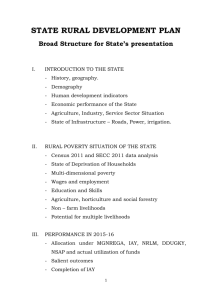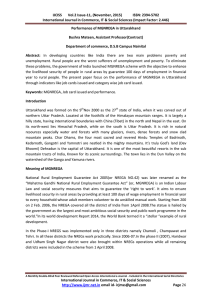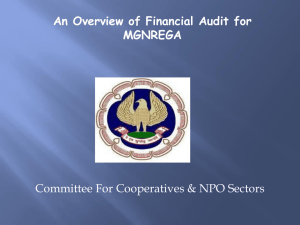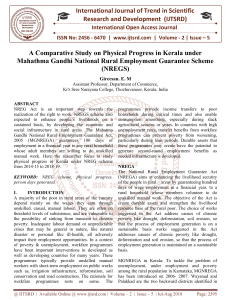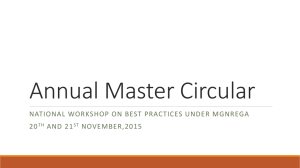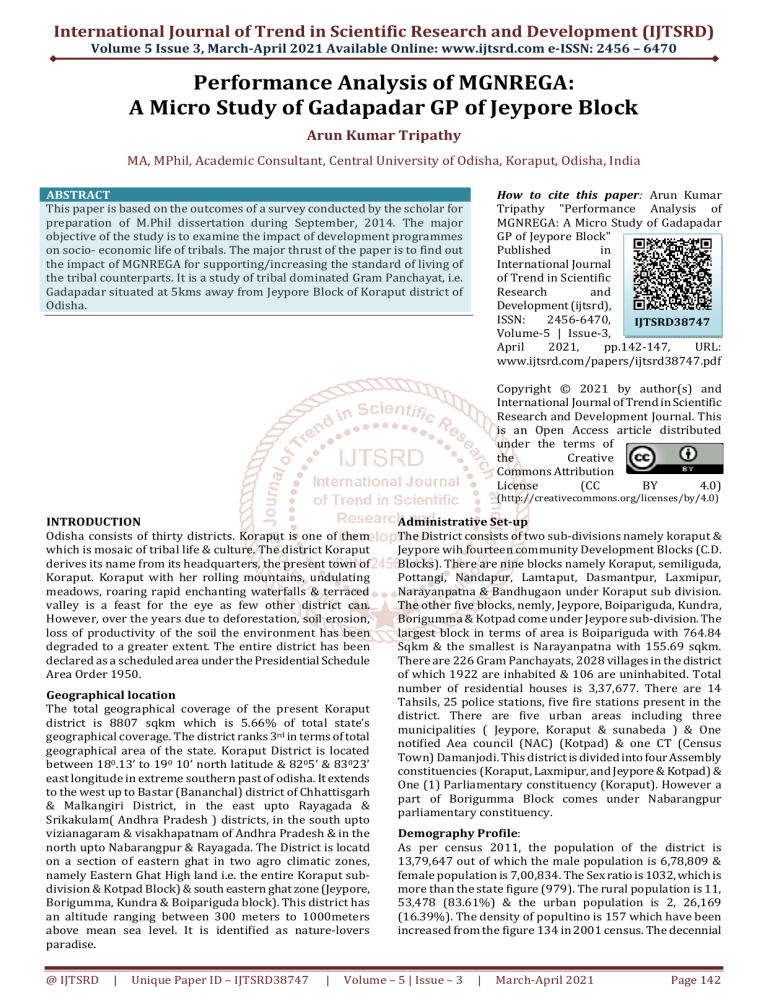
International Journal of Trend in Scientific Research and Development (IJTSRD) Volume 5 Issue 3, March-April 2021 Available Online: www.ijtsrd.com e-ISSN: 2456 – 6470 Performance Analysis of MGNREGA: A Micro Study of Gadapadar GP of Jeypore Block Arun Kumar Tripathy MA, MPhil, Academic Consultant, Central University of Odisha, Koraput, Odisha, India How to cite this paper: Arun Kumar Tripathy "Performance Analysis of MGNREGA: A Micro Study of Gadapadar GP of Jeypore Block" Published in International Journal of Trend in Scientific Research and Development (ijtsrd), ISSN: 2456-6470, IJTSRD38747 Volume-5 | Issue-3, April 2021, pp.142-147, URL: www.ijtsrd.com/papers/ijtsrd38747.pdf ABSTRACT This paper is based on the outcomes of a survey conducted by the scholar for preparation of M.Phil dissertation during September, 2014. The major objective of the study is to examine the impact of development programmes on socio- economic life of tribals. The major thrust of the paper is to find out the impact of MGNREGA for supporting/increasing the standard of living of the tribal counterparts. It is a study of tribal dominated Gram Panchayat, i.e. Gadapadar situated at 5kms away from Jeypore Block of Koraput district of Odisha. Copyright © 2021 by author(s) and International Journal of Trend in Scientific Research and Development Journal. This is an Open Access article distributed under the terms of the Creative Commons Attribution License (CC BY 4.0) (http://creativecommons.org/licenses/by/4.0) INTRODUCTION Odisha consists of thirty districts. Koraput is one of them which is mosaic of tribal life & culture. The district Koraput derives its name from its headquarters, the present town of Koraput. Koraput with her rolling mountains, undulating meadows, roaring rapid enchanting waterfalls & terraced valley is a feast for the eye as few other district can. However, over the years due to deforestation, soil erosion, loss of productivity of the soil the environment has been degraded to a greater extent. The entire district has been declared as a scheduled area under the Presidential Schedule Area Order 1950. Geographical location The total geographical coverage of the present Koraput district is 8807 sqkm which is 5.66% of total state’s geographical coverage. The district ranks 3rd in terms of total geographical area of the state. Koraput District is located between 180.13’ to 190 10’ north latitude & 8205’ & 83023’ east longitude in extreme southern past of odisha. It extends to the west up to Bastar (Bananchal) district of Chhattisgarh & Malkangiri District, in the east upto Rayagada & Srikakulam( Andhra Pradesh ) districts, in the south upto vizianagaram & visakhapatnam of Andhra Pradesh & in the north upto Nabarangpur & Rayagada. The District is locatd on a section of eastern ghat in two agro climatic zones, namely Eastern Ghat High land i.e. the entire Koraput subdivision & Kotpad Block) & south eastern ghat zone (Jeypore, Borigumma, Kundra & Boipariguda block). This district has an altitude ranging between 300 meters to 1000meters above mean sea level. It is identified as nature-lovers paradise. @ IJTSRD | Unique Paper ID – IJTSRD38747 | Administrative Set-up The District consists of two sub-divisions namely koraput & Jeypore wih fourteen community Development Blocks (C.D. Blocks). There are nine blocks namely Koraput, semiliguda, Pottangi, Nandapur, Lamtaput, Dasmantpur, Laxmipur, Narayanpatna & Bandhugaon under Koraput sub division. The other five blocks, nemly, Jeypore, Boipariguda, Kundra, Borigumma & Kotpad come under Jeypore sub-division. The largest block in terms of area is Boipariguda with 764.84 Sqkm & the smallest is Narayanpatna with 155.69 sqkm. There are 226 Gram Panchayats, 2028 villages in the district of which 1922 are inhabited & 106 are uninhabited. Total number of residential houses is 3,37,677. There are 14 Tahsils, 25 police stations, five fire stations present in the district. There are five urban areas including three municipalities ( Jeypore, Koraput & sunabeda ) & One notified Aea council (NAC) (Kotpad) & one CT (Census Town) Damanjodi. This district is divided into four Assembly constituencies (Koraput, Laxmipur, and Jeypore & Kotpad) & One (1) Parliamentary constituency (Koraput). However a part of Borigumma Block comes under Nabarangpur parliamentary constituency. Demography Profile: As per census 2011, the population of the district is 13,79,647 out of which the male population is 6,78,809 & female population is 7,00,834. The Sex ratio is 1032, which is more than the state figure (979). The rural population is 11, 53,478 (83.61%) & the urban population is 2, 26,169 (16.39%). The density of popultino is 157 which have been increased from the figure 134 in 2001 census. The decennial Volume – 5 | Issue – 3 | March-April 2021 Page 142 International Journal of Trend in Scientific Research and Development (IJTSRD) @ www.ijtsrd.com eISSN: 2456-6470 growth of popultion of the district is 16.86% which is higher than the state figure (14.05) The ST & SC population of the district combined form 64.48% to the total population. The ST Population is 6,97,583 (50.56%) & SC population is 1,96,540 (14.24%). In rural areas, the ST population is 6,62,719 (95.00%) & 34,864(4.99%) in urban areas. Similarly 1,60,697(81.76%)) of SCs are living in rural areas whereas only 35,843(18.23%) of them are living in urban areas. Literacy & Educational Institutions The overall literacy rate of the district is 49.2% which consists of 60.3% males & 38.6% females (2011 census) with a gender gap of 19.99%. the urban literacy level of the district is 81.8%, where as the rural literacy rate is 42.4%. the overall literacy rate for all categories was 35.72% in Koraput district during 2001 census which consists of 47.20% males & 24.26% females. According to 2001 Census, the ST & SC literacy rate is 18.68% & 35.43% respectively. (The said figure for 2011 Census is not at hand). About the Gram Panchayat Gadapadar Gramapanchayat is one of the 22 GPs of Jeypore block in Koraput district of Odisha. The Gram Panchayat was established in the year of 1950s. It consists of seven revenue village namely, Chotadiput, Dubuli, Gadapadar, Harddoli, Kolaguda, Kota & Paliguda and also with that of 6 hamlets. There are eight Angan Wadi Centers, one Upper Primary School & one High School. The population of the GP was 3847 for 2001 census with 933 Households. ST population covers 49.87% of the total population. Objectives The main objectives of the study are :1. To find out the awarness level among the villagers about various socio-economic schemes ; 2. To findout the physical and financial progress of MGNREGA 3. To provide some humble suggestions for better implementation of development programme in the light of “Conservation cum- Development. Hypotheses The main hypotheses for the proposed study are :1. MGNREGA is a significant factor of economic development of beneficiaries 2. There is no significant relationship between overall well being of beneficiaries and employment opportunities. Research Questions 1. MGNREGA enhances food security 2. MGNREGA provided some protection against extreme poverty 3. MGNREGA helped to reduce the distress migration 4. MGNREGA helped to reduce indebtedness 5. MGNREGA gave greater economic independence to women 6. MGNREGA generated better purchasing power in the local economy 7. MGNREGA has increased the local wage rate 8. MGNREGA has improved the scope of the children to go to school 9. The quality of MGNREGA work is satisfactory 10. Zero corruption exists in MGNREGA work 11. Improvement in roads and communication due to MGNREGA 12. Work MGNREGA work has improved the water level @ IJTSRD | Unique Paper ID – IJTSRD38747 | MGNREGA: A BIRD’S EYE VIEW The Mahatma Gandhi National Rural Employment Guarantee Act (MGNREGA), also known as Mahatma Gandhi National Rural Employment Guarantee Scheme (MNREGS) is Indian legislation enacted on August 25, 2005. The MGNREGA provides a legal guarantee for one hundred days of employment in every financial year to adult members of any rural household willing to do public work-related unskilled manual work at the statutory minimum wage. The Ministry of Rural Development (MRD), Govt of India is monitoring the entire implementation of this scheme in association with state governments This act was introduced with an aim of improving the purchasing power of the rural people, primarily semi or unskilled work to people living below poverty line in rural India. It attempts to bridge the gap between the rich and poor in the country. Roughly one-third of the stipulated work force must be women. Adult members of rural households submit their name, age and address with photo to the Gram Panchayat. The Gram Panchayat registers households after making enquiry and issues a job card. The job card contains the details of adult member enrolled and his /her photo. Registered person can submit an application for work in writing (for at least fourteen days of continuous work) either to Panchayat or to Programme Officer. The Panchayat/Programme officer will accept the valid application and issue dated receipt of application, letter providing work will be sent to the applicant and also displayed at Panchayat office. The employment will be provided within a radius of 5 km: if it is above 5 km extra wage will be paid. Methodology Universe The Koraput district is the universe for the proposed study Census The Jeypore block of Koraput district is the cessus for the proposed study Sample and Sampling Out of 22 GPs of Jeypore block, 1 GP, i.e. Gadapadar has purposefully taken as sample( using purposive sampling) for evaluating the impact of MGNREGA. Data Collection and Analysis The primary data would collected through Interview schedule & personal interview. A structured Interview schedule would designed to find out responses for the impact of MGNREGA. The sources of secondary data included Internet, magazines, journals and books from various concerning libraries and official website of MGNREGA and discussions with the Block Officials. Tools For Data Analysis Simple statistical tools like average, percentage, etc will be used to analyse the data collected and diagrams like Piechart, Bar-Diagram will be used to present the analysis in graphical/ photo pictorial forms. As according to the sources out of 2415 nos. of persons were registered for the scheme, the employment were provided to 1068 nos. of persons between the financial years 2017-18 & 18-19. Volume – 5 | Issue – 3 | March-April 2021 Page 143 International Journal of Trend in Scientific Research and Development (IJTSRD) @ www.ijtsrd.com eISSN: 2456-6470 Table-1.01-MGNREGA Statistics of Gadapadar GP Employment provided to the persons 1068 Total Persons Registered 2415 SCs 631 STs 1287 Other 497 women 1171 Source – Block office, Jeypore Diagrammatical Representation of Category of Work Fund Allocation The table of 1.02 gives us information about the fund allocation for the scheme during the financial year, 2017-18 & 2018-19. Table-1.02-Funds invested in FY FY AMOUNT(IN LAKHS) 2018-19 18.11 2017-18 24.91 Works done under the scheme From the date of inception, whatever be the works, which has undertaken under the scheme of MGNREGA has been showed through the table, 1.03. Table-1.03-Works undertaken under MGNREGA during the financial years 2006-07to 2018-19 Sl No. Category of the work Nos of such works in the whole Gram Panchayat 1. Guard wall 12 2. Farm pond 09 3. Check dam 05 4. Renovation of tank 04 5. Construction of tank 05 6. Completion of uncompleted road 14 7. Earthern road 08 8. Road with ghat cutting 07 9. Protection ,management and enrichment of VSS 03 10. Slit clearance, Bank strengthen of Cannals 12 11. PMGSY Road 07 12. BNRGS KENDRAS 01 13. Construction of road with ghat cutting 09 14. Construction of play ground 04 15. Improvement of road with metalling 09 16. Improvement of tank 08 17. Construction of IHHL 17 18. Road with Culvert 12 19. Formation of Road 09 20. Construction of earthern F/C 11 21. Multipurpose firm pond 11 22. IAY House 22 23. BPGY House 14 @ IJTSRD | Unique Paper ID – IJTSRD38747 | Volume – 5 | Issue – 3 | March-April 2021 Page 144 International Journal of Trend in Scientific Research and Development (IJTSRD) @ www.ijtsrd.com eISSN: 2456-6470 24. 25. 26. 27. 28. 29. 30. 31. 32. 33. 34. 35. 36. 37. AWC Centre Innstitutional Plantation Cattle Pucca Floor Cattle Shed Field Channel Construction of Drying Yard at Grave Yard Drain MM Road Construction of G/C Excavation of Tank Dug-Well Community Dug Well Implementation of S/M PMAY House 06 03 05 09 08 04 10 04 05 07 08 04 06 06 Diagrammatical Representation of the works done under MGNREGA in the whole GP Result of Interaction with Interview Schedule The villagers are very much satisfied with the works done under MGNREGA, but due to using of machines instead manual labour, they are suffered. Excavation/ creation of tank, construction of field channel & dug well has developed their agricultural practices manifold. Ghat cutting was not done earlier, due to some problems, but the Ghat cutting and creation of new road the village Kota has developed the communication manifold. Earlier the villager has to walk 22 kms by different ways to go the GP office, but now they have @ IJTSRD | Unique Paper ID – IJTSRD38747 | to travel only 8kms. Further the creation of drying yard at graveyard has benefitted them a lot. Limitation of the Study As the scholar is limiting the sample to a GP, it may not be able to present a comprehensive picture of the MGNREGA. The respondents would have answered the questions put to them from their memorie which may not be true. The limitatin of time and finance has made by the scholar to limit he study. However, care has been taken to overcome these Volume – 5 | Issue – 3 | March-April 2021 Page 145 International Journal of Trend in Scientific Research and Development (IJTSRD) @ www.ijtsrd.com eISSN: 2456-6470 difficulties by making focus group discussion and get it verified with the available data from the block and mgnrega website. It is expected that the sample in the study will represent the universe in a meaningful manner. Major Loopholes of MGNREGA Scheme: Though MGNREGA has provided a fair opportunity to people from rural India to earn their own income without any discrimination of caste or gender, the scheme is marked by some limitations. These are as follows: One of the major shortcomings of the Act is nonavailability of child care and raring facilities at the work site even though the Act includes this provision. Different studies show that women remained worried about their children while they are working at MGNREGA worksite Even some women do not accept the job facilities of MGNREGA because of nonavailability of proper child care facilities. MGNREGA funds have been allocated for the provision of safe drinking water, resting place, changing room, first aid and recreational facility for children etc. But different studies revealed that except drinking water facility all other facilities were generally absent. The working women are not satisfied and they said that they had not got any other facility provided by MGNREGA. Most of the studies show that there is delay in payment of MGNREGA which is also responsible for poor participation0020of people. Low level of awareness of the people about the process and entitlements of the programme is another drawback of the scheme. Another loophole of the scheme is the involvement of the contractors which directly affect the beneficiary. SUGGESTIONS There is a low awareness among some women workers of MGNREGA. To come out of this anomaly more awareness campaigns have to be conducted to educate the people about the provisions of the programme. There is delay in making the payment of wages in the case of some workers. To avoid this appropriate steps are to be taken by the government to maintain the uniformity in wage payment. Steps are to be taken to mitigate the problem of harassment of women at the worksites. Some of the worksite facilities are very poor. So the steps should be taken to provide adequate worksite facilities. For this purpose separate mechanism should be evolved. For comprehensive participation of women the women should be allowed to involve in planning for MGNREGS. Women participation can be enhanced by appointing female supervisors on MGNREGS works and in conducting social audits Women should be involved in the selection of works, which can create further mainstream employment in the village The provision of food for women at the work sites creates enthusiasm among women to participate in MGNREGS works. Designing special Statement of Rates (SOR) for women, preferably through conducting a systematic time and motion study, to ensure that they earn the set minimum wages. Providing 100 days of work should be made mandatory to all including women workers, as this will accelerate the process of women’s empowerment. Improving the quantity of employment of MGNREGS by implementing all entitlements of workers including payment of the legal minimum wages, @ IJTSRD | Unique Paper ID – IJTSRD38747 | work site facilities and dependable first aid facilities. In addition, it is important to add some minimum social security such as health insurance. In other words, MGNREGS work needs to move towards quality employment. Changes need to be made in the provision of asset ownership (on private as well as public lands) and in the distribution of returns of MGNREGS assets. When more than 100 million assets have been constructed under MGNREGS so far, it is necessary to develop a fair and just approach for asset ownership. In this context, we would like to recommend (1) joint ownership of all MGNREGA assets constructed on private lands, (2) fair share of women in the community assets and (3) just distribution of these assets between men and women. Finally, MGNREGS implements as well as their maintenance are costly for MGNREGS workers. It costs time as well as money. It will be extremely useful if these are provided by the local Village Panchayat and their timely maintenance is also ensured by them. While concluding this study, one can observe that the positive and negative impacts of MGNREGA on women’s empowerment cannot be ignored on the grounds that these are unintended or not covered under the main objectives of MGNREGA. By addressing these impacts will not only help women’s empowerment but it will also help in achieving medium and long term goals of MGNREGA and help in moving towards optimum use of labour in the economy. It will also help in moving towards some desirable national level social policies. Conclusion: MGNREGA is one of the largest rural development programme implemented in India. Rural areas were most affected with the problem of poverty and non-availability of opportunities to work in hometowns. The rural people were always in hardship and were forced to suicide. In this backdrop, the MGNREGA proved to be miracle for the poor in the rural areas. The MGNREGA provides at least 100 days guaranteed wage employment for all who demands for work. Women are given guaranteed one-third share in the total employment. Marginalized groups, for example SCs, STs & others, are allowed to get developed own private lands. All these provisions in the act make MGNREGA more inclusive. In the villages, the infrastructure is created which is of prime importance for the development of the rural as well as the urban areas. However, the government needs to amend the MGNREGA to provide more employment for unskilled manual work regularly. So it is recommended that the present programme should be further spread in the rural areas by means of proper planning, adequate supervision and effective implementation and better monitoring so that the country will get fruitful benefit and helps to overcome from unemployment, reduced migration, reduces poverty etc. Reference [1] MGNREGA SAMEEKSHA : Development, Govt. of India Ministry of Rural [2] www.nrega.nic.in [3] Sharma Rakesh & Didwania Manish-Performance Analysis Of Mgnrega : A Case Study Of District Jind , Zenith International Journal Of Business Economics And Management, August,2013 [4] Dheeraj R P : A Critical Analysis Of MGNREGA, Global Journal Of Interdisciplinary Social Science, NOV-DEC, 2017 Volume – 5 | Issue – 3 | March-April 2021 Page 146 International Journal of Trend in Scientific Research and Development (IJTSRD) @ www.ijtsrd.com eISSN: 2456-6470 [5] Sugapriyan G & Prakasham S : Analyzing the performance of MGNREGA Scheme using Data Mining Technique, International Journal of computer application, January, 2015 [6] Das Darshan -Role of MGNREGA In In Rural Employment : A Study Of Barpeta District Of Assam, IJHSSS, May, 2016 [7] [8] Tripathy A K- Impact of development programmes on socio economic life of tribal- a micro study of Gadapadar GP of Jeypore Block-MPhil Dissertation, COATS Library Koraput. Bisoyi, Prasanta Kumar (2006), Communication Barriess in Tribal Development (M. Phil. Dissestation) COATS Library, Koraput. [9] Tandi, Nandi Kishor (2006), Tribal Development Schemes & Programmes (M. Phil Dissertation) COATS Library Koraput. [10] Singh S. P. and Nauriyal D. K. (2009), System and Process Review and Impact Assessment of NREGA in the State of Uttrakhand, Indian Institute of Technology, Roorkee. @ IJTSRD | Unique Paper ID – IJTSRD38747 | [11] Chathur Kulum J. and M.S. John (1999), “Decentralised Planning and Panchayats in Kerala”, Kurukshetra, Vol. 47, No. 12, p. 20. [12] Joshi Sandeep (2000), Panchayati Raj Institutions and Poverty Alleviation, Rawat Publication, Jaipur. [13] Singh S. P. and Nauriyal D. K. (2009), System and Process Review and Impact Assessment of NREGA in the State of Uttrakhand, Indian Institute of Technology, Roorkee. [14] All-India Report on Evaluation of NREGA: Survey of 20 Districts (2008), Institute of Applied Manpower Research Plot No. 25, Sector A-7, Narela, Delhi. [15] Gupta D.N. (2001), Rural Development System, Books India International, New Delhi. [16] John Icy K. (2006), Panchayati Raj Institutions and Rural Development of Kerala, Ph.D. [17] Thesis, Mahatma Gandhi University, Kottayam, p.p. 276-277. [18] Kumar Arvind (2001), Encyclopedia of Decentralised Planning and Local Self-Governance, Vol. III, Laxmi Shikshan Sansthan, Lucknow and Anmol Publications Pvt.Ltd., New Delhi. Volume – 5 | Issue – 3 | March-April 2021 Page 147
